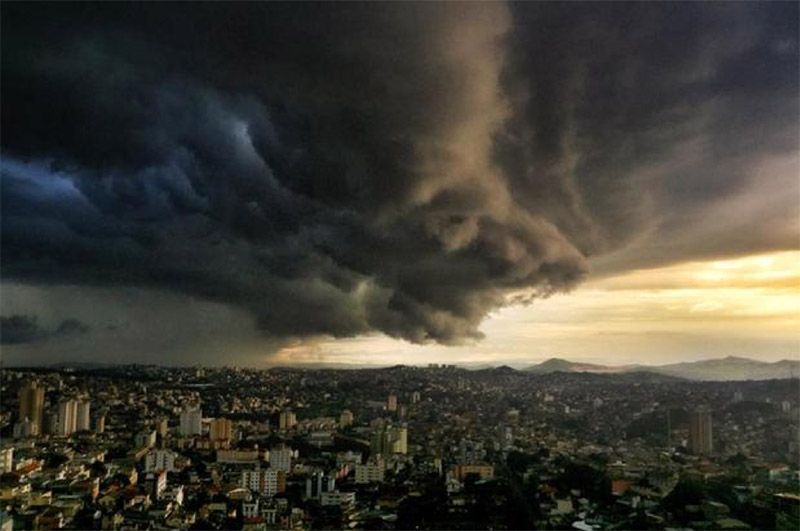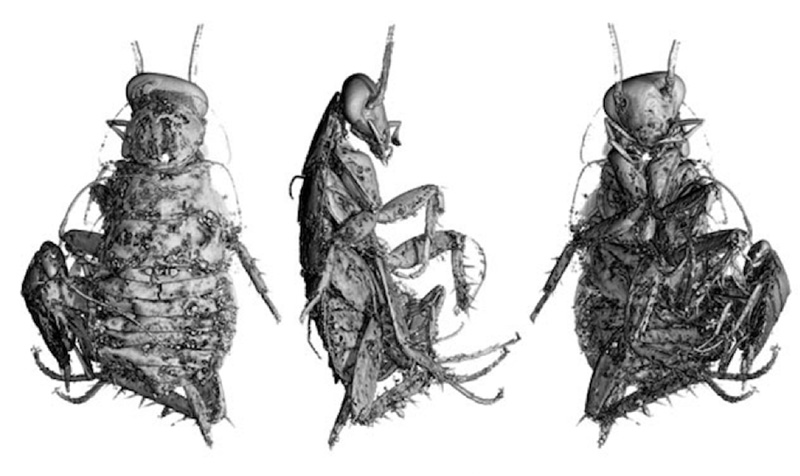
Storm clouds over Minas Gerais. Photo by Mariela Guimarães (Pedro Rocha Franco and Jefferson Delbem 2020).
The January 2020 floods in Minas Gerais, Brazil were catastrophic for the communities of the more than fifty people who lost their lives to the disaster and for the hundreds more displaced in its wake (Lima 2020). Such disasters often seem chaotic and unpredictable eruptions, but in the time of the climate crisis and amidst decaying support for democratic institutions, disasters like these floods are likely to become more common and more dangerous.
From 2017 to 2018, I conducted fieldwork within the state of Minas Gerais’ Secretary for the Environment and Sustainable Development (SEMAD), working with a team of environmental scientists advising the ministry on climate change governance. As I inquired about their safety in the past few weeks, one lamented to me: “It’s like we warned the government… no planning, no climate risk management.” His response was ominous. Despite the best efforts of the team over the past decade, the Minas Gerais government still finds itself unprepared to address climate disasters.
What is it like to plan for the planetary threat of the climate crisis while working within a beleaguered state bureaucracy that faces new challenges every day, either from more-than-human environments or the growing wave of authoritarianism that plagues Brazilian environmental politics? I argue that many of the concepts traditionally used by state planners and anthropology to make sense of the world no longer apply. Our ways of thinking and acting are increasingly overwhelmed. I suggest anthropology may have something to gain from embracing the horror genre to find our way through these challenges.
Weird New World
Climate change is making things weird. While many of the risks are familiar (floods, droughts, heatwaves, etc.), many are not. São Paulo hospitals have been running short on scorpion anti-venom amid rising demand as scorpions increasingly move away from their typical habitats, destroyed by development and ecosystem degradation, and adapt to Brazil’s megacities (Alves 2019; Phillips 2018). At the same time as the Mineiro floods, the US National Weather service warned Miami residents to look out for iguanas falling out of trees as uncharacteristically cold weather hit the Gulf coast (Chinchar 2020). Preparing for the climate crisis means expecting the unexpected.
Addressing the failure of mainstream literature to address the climate crisis, novelist-anthropologist Amitav Ghosh argues that “the climate crisis is also a crisis of culture, and thus of the imagination” (2016, 9). The history of anthropology, like the history of literature, occurred almost entirely during seemingly stable climatic conditions. This perceived stability shaped how the discipline considered issues of the climate and of change more generally. Whether we call our current situation the “Anthropocene,” the “capitalocene,” the “chthulucene,” or any other term, the conditions have changed. As was particularly evident for climate advisors in Brazil, it is becoming increasingly unwise to assume that tomorrow will look like today.
Grotesque Understandings

Image by the European Synchrotron Radiation Facility (Marchant 2009).
What can anthropology learn from the horror genre? Consider the ways that horror plays with understanding. In Clarice Lispector’s The Passion According to G.H., an upper-class woman living in Rio de Janeiro happens across a cockroach scuttling out of her former maid’s closet. Shocked by the intruder, G.H. slams the closet door, severing the cockroach in half. As its viscera oozes out of its body, G.H. becomes transfixed by the gore. Through her inner-monologue, the reader watches G.H. lose herself in the guilt of having wronged a living creature, who she begins to identify as both a divine spirit and a demonic encapsulation of the world. In order to atone and make things whole again, G.H. becomes convinced that she must eat the cockroach to attain redemption. She swallows the flesh, but the dark sacrament was too intense for her merely human body. She vomits, and as her body forcefully separates itself from the cockroach, G.H leaves her trance and returns to her daily life, declaring, “I will never again understand what I say” (Lispector 1998, 122).
Lispector’s story is grotesque, but “the grotesque demonstrates that there are things for which we do not have categories, and, therefore, that our ways of making meaning are artificial” (Malcolm-Clark 2008, 339). In surrealist and horrific stories like Lispector’s, confidence in the narrator’s ability to provide a clear-cut explanation for events vanishes. The narrator, the subject, and the reader are all likely to find themselves lost in an overwhelming barrage of disorienting experiences.
Anthropology of Eco-Horror
Reading through a state-wide climate vulnerability assessment prepared by SEMAD, I found myself feeling similarly overwhelmed. So-called grey literature publications are not written with the intention to evoke strong reactions, yet despite the dry presentation one might expect from a government publication, the vulnerability assessment manifests anxieties about the concept-shattering grotesqueness of the climate crisis.
Reflecting in particular on past floods in Minas Gerais, it became clear that a flood is not just water. It is the entry of toxic chemicals into a river during piracema, the period Krenak indigenous peoples recognize as the beginning and end of sacred fish lifecycles (Neiva 2016). A flood can be the start of an uncertain legal battle that will occupy regulators for years. A flood is the impetus to abandon one’s home and move to a rapidly growing city. A flood is the creation of new habitats for mosquitos to lay eggs, bringing viruses like Dengue, Zika, and Yellow Fever closer to human populations.
Assessing vulnerability is not a simple matter. On the one hand, the report attempts to project the severity of untold disasters to come. How frequently will Minas Gerais flood? How intensely will heatwaves scorch the earth? How many new diseases will spread from a growing mosquito population? On the other hand, the report attempts to consider the possible and expected reactions of populations affected by these disasters. How will farmers react to massive crop deaths? How will public health infrastructures account for the influx of new patients? How will transportation networks adapt to worsening road conditions?
As past ways of life become untenable, some react by throwing themselves into nostalgic forms of politics, grasping for stability through calls for greater security by insisting on the right to carry firearms, increasing police presence, and supporting strongman politicians. The election of Jair Bolsonaro cannot be separated from environmental degradation, and his administration’s subsequent attacks on the Brazilian environment and indigenous peoples should not be considered a mere coincidence.
The intricate feedback loops and complex system dynamics linking them together make these challenges particularly terrifying. Scholars can consider none of these questions in complete isolation from any of the others. Predicting vulnerabilities to a phenomenon that truly changes everything, as Naomi Klein (2014) argues, is an almost absurd yet necessary task. We are well past the point of needing Bruno Latour (1993) to remind us that “nature” and “culture” are hybridized by events like climate change. The question now facing climate advisors is what to do with a world where monstrous entanglements of everything with everything are becoming increasingly clear. Like G.H., I found myself lost in the grotesqueness of the material.
References
Alves, Gabriel. 2019. “Ataques de Escorpiões Aumentam 80% Nos Últimos Cinco Anos.” Folha de São Paulo, January 31, sec. Ciência. https://www1.folha.uol.com.br/ciencia/2019/01/ataques-de-escorpioes-aumentam-80-nos-ultimos-cinco-anos.shtml.
Chinchar, Allison. 2020. “National Weather Service Warns of Falling Iguanas.” CNN, January 22, sec. Weather. https://www.cnn.com/2020/01/21/weather/miami-freeze-falling-iguana-forecast-trnd/index.html.
Ghosh, Amitav. 2016. The Great Derangement: Climate Change and the Unthinkable. Chicago: University Of Chicago Press.
Klein, Naomi. 2014. This Changes Everything: Capitalism vs. the Climate. Toronto: Knopf Canada.
Latour, Bruno. 1993. We Have Never Been Modern. Cambridge, MA: Harvard University Press.
Lima, Déborah. 2020. “Chega a 59 o Número de Mortes após as Chuvas em Minas.” Estado de Minas, February 8. https://www.em.com.br/app/noticia/gerais/2020/02/08/interna_gerais,1120493/chega-a-59-o-numero-de-mortes-apos-as-chuvas-em-minas.shtml.
Lispector, Clarice. 1998. A Paixão Segundo G.H. Rio de Janeiro: Rocco.
Malcolm-Clarke, Darja. 2008. “Tracking Phantoms.” In The New Weird, edited by Ann VanderMeer and Jeff VanderMeer, 337–44. San Francisco: Tachyon Publications.
Marchant, Jo. 2009. “Virtual Fossils Reveal How Ancient Creatures Lived.” New Scientist, May 27. https://www.newscientist.com/article/mg20227103.500-virtual-fossils-reveal-how-ancient-creatures-lived/.
Neiva, Julia Mello. 2016. Entrevista Com Shirley Krenak/Interview with Shirley Krenak. https://www.youtube.com/watch?v=CnI99Siq-ak.
Phillips, Dom. 2018. “Scorpion Deaths on Rise in Brazil as Arachnid Adapts to Urban Life.” The Guardian, July 15, sec. World News. https://www.theguardian.com/world/2018/jul/15/scorpion-deaths-rise-brazil-cities-urban-adaptation-risks.
Rocha Franco, Pedro and Jefferson Delbem. 2020. “Defesa Civil Alerta para Chuva de Granizo em 69 Cidades de Minas Gerais.” O Tempo, January 29, sec. Cidade. https://www.otempo.com.br/cidades/defesa-civil-alerta-para-chuva-de-granizo-em-69-cidades-de-minas-gerais-1.2290615.
